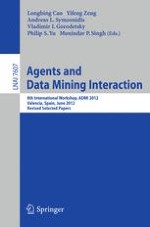2013 | Buch
Agents and Data Mining Interaction
8th International Workshop, ADMI 2012, Valencia, Spain, June 4-5, 2012, Revised Selected Papers
herausgegeben von: Longbing Cao, Yifeng Zeng, Andreas L. Symeonidis, Vladimir I. Gorodetsky, Philip S. Yu, Munindar P Singh
Verlag: Springer Berlin Heidelberg
Buchreihe : Lecture Notes in Computer Science
